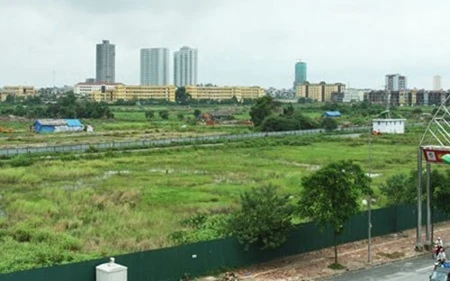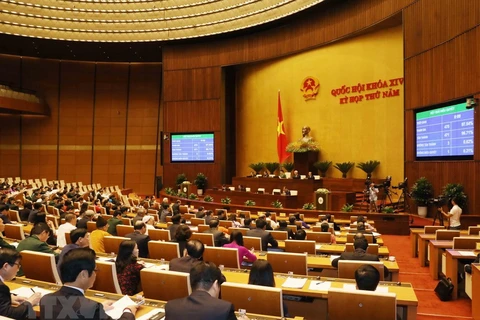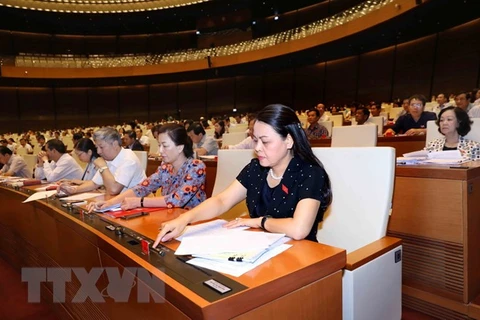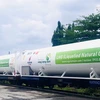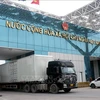Hanoi (VNA) – Farming land transfer and renting activities, motivated by the transition of the agricultural economy towards larger scale modernisation, have become busy recently, initiating the development of the agricultural land use market in Vietnam. However, the Land Law 2013 has yet to catch up with the trend, leading to many difficulties in the market.
A 2016 report released by the Central Steering Committee for Agricultural, Rural, and Fishery Census showed that of the total farming land area of 27.3 million hectares, 24.4 million hectares (or about 90 percent) were allocated to users. The rest has been managed by the People’s Committees of communes.
Among the farming land users, 98.7 percent are households and domestic economic organisations. Each household on average owned 2.5 plots with a combined average area of 1,800sq.m.
According to Dr Le Thanh Y from the Central Institute for Economic Management (CIEM), the legal framework is ultimately the deciding factor that turns land into goods. Only land plots meeting all legal conditions can take part in market activities. He underlined that land use certification is one of the foundations to ensuring the legality when using farming land as goods.
Currently, 90 percent of agricultural land has been allocated to specific owners, including farmers and agro-forestry-fisheries companies who are the secondary supply sources for the market.
However, during the modernisation process, the growth of industry and service sectors led to a decline in the number of labourers in the agricultural sector, and as such, a drop in the faming land demand.
The redundant area of farming land by households has increased and changed into non-farming land, creating major supply sources for the market. The equitisation and dissolution of agro-forestry-fisheries companies have also generated about 452,000 hectares of land for the market.
Moreover, the market demand of agricultural land has increased, mostly from big farmer households and businesses investing in the agricultural sector. The number of such firms increased by 49 percent to 3,846 in 2016, from only 2,569 in 2011.
A survey by the CIEM covering 3,700 households in 12 provinces saw that the land trading activities were busier than land renting activities. The ratio of households conducting land transfer activities was 16.6 percent, while the rate of renting was only 7.1 percent. The engagement of big firms in the agriculture sector has changed production practices, with the formation of giant farms with average areas of 250 hectares.
The Land Law 2013 has hindered the accumulation of farming land – as a non-agricultural economic organisation cannot receive the authority to use farming land – together with land use limitations.
Therefore, in order to boost the efficiency of land use and avoid the waste of land resources, many experts held that it is necessary to build a more suitable policy framework, aiming to deal with existing obstacles facing the expansion of the agricultural land market.
Experts also pointed to six specific areas in land use policy that needs adjusting, namely land use planning; land renting; the rights of land users; limits and land renting duration; infrastructure serving the transactions of land use rights; and land reclaiming.-VNA
A 2016 report released by the Central Steering Committee for Agricultural, Rural, and Fishery Census showed that of the total farming land area of 27.3 million hectares, 24.4 million hectares (or about 90 percent) were allocated to users. The rest has been managed by the People’s Committees of communes.
Among the farming land users, 98.7 percent are households and domestic economic organisations. Each household on average owned 2.5 plots with a combined average area of 1,800sq.m.
According to Dr Le Thanh Y from the Central Institute for Economic Management (CIEM), the legal framework is ultimately the deciding factor that turns land into goods. Only land plots meeting all legal conditions can take part in market activities. He underlined that land use certification is one of the foundations to ensuring the legality when using farming land as goods.
Currently, 90 percent of agricultural land has been allocated to specific owners, including farmers and agro-forestry-fisheries companies who are the secondary supply sources for the market.
However, during the modernisation process, the growth of industry and service sectors led to a decline in the number of labourers in the agricultural sector, and as such, a drop in the faming land demand.
The redundant area of farming land by households has increased and changed into non-farming land, creating major supply sources for the market. The equitisation and dissolution of agro-forestry-fisheries companies have also generated about 452,000 hectares of land for the market.
Moreover, the market demand of agricultural land has increased, mostly from big farmer households and businesses investing in the agricultural sector. The number of such firms increased by 49 percent to 3,846 in 2016, from only 2,569 in 2011.
A survey by the CIEM covering 3,700 households in 12 provinces saw that the land trading activities were busier than land renting activities. The ratio of households conducting land transfer activities was 16.6 percent, while the rate of renting was only 7.1 percent. The engagement of big firms in the agriculture sector has changed production practices, with the formation of giant farms with average areas of 250 hectares.
The Land Law 2013 has hindered the accumulation of farming land – as a non-agricultural economic organisation cannot receive the authority to use farming land – together with land use limitations.
Therefore, in order to boost the efficiency of land use and avoid the waste of land resources, many experts held that it is necessary to build a more suitable policy framework, aiming to deal with existing obstacles facing the expansion of the agricultural land market.
Experts also pointed to six specific areas in land use policy that needs adjusting, namely land use planning; land renting; the rights of land users; limits and land renting duration; infrastructure serving the transactions of land use rights; and land reclaiming.-VNA
VNA

